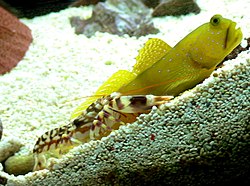
Back Simbiose Afrikaans تكافل (أحياء) Arabic Simbioz Azerbaijani سیمبیوز AZB Сімбіёз Byelorussian Сымбіёз BE-X-OLD Симбиоза Bulgarian Simbioza BS Simbiosi Catalan ھاوگوزەرانی CKB

goby fish keeps lookout
Symbiosis (pl. symbioses) means living together. It describes close and long-term relationships between different species. The term was used by Anton de Bary in 1869, as "the living together of unlike organisms".[1][2][3]
A symbiont is an organism living in a relationship with another species in which one or both get benefits.[4] When one species lives inside another species, or a microscopic symbiont lives inside the cells of a host, it is called an endosymbiont.
The relevance of symbiosis is its frequency and its evolutionary significance. There appear to be no higher plants or animals without symbionts. Those symbionts are of great importance to the larger organisms, who in most cases would be unable to live as they do without their symbionts. Mycorrhiza in higher plants, and gut flora in insects and vertebrates are examples. Humans are no exception.[5][6]
Furthermore, most of these associations are between organisms not just from different species, but from different kingdoms. And lastly, the cells of all eukaryotes contain organelles which are descendants of symbiotic relationships which began at least a billion years ago. Mitochondria and plastids are examples. The conclusion must be that symbiosis has been highly significant in the evolution of life.
- ↑ de Bary, Anton 1879. Die Erscheinung der Symbiosis. In Verlag auf der Versammlung der Naturforscher und Artze zu Cassel. Strassburg.
- ↑ Schwendener, Simon 1868. Unter suchungen über den Flechtenthallus. Beiträge zur wissenschaftlichten Botanik 6, 195–207.
- ↑ Crombie J.M. 1886. On the algae-lichen hypothesis. J Linn. Soc. 21, 259–282.
- ↑ King R.C. Stansfield W.D. & Mulligan P.K. 2006. A dictionary of genetics, 7th ed. Oxford.
- ↑ Guarner F, Malagelada JR (2003). "Gut flora in health and disease". Lancet. 361 (9356): 512–9. doi:10.1016/S0140-6736(03)12489-0. PMID 12583961. S2CID 38767655.
- ↑ Sears CL (2005). "A dynamic partnership: celebrating our gut flora". Anaerobe. 11 (5): 247–51. doi:10.1016/j.anaerobe.2005.05.001. PMID 16701579.